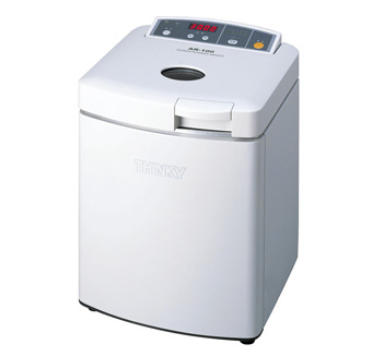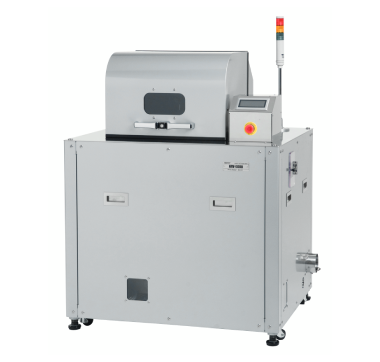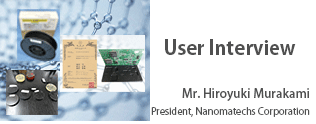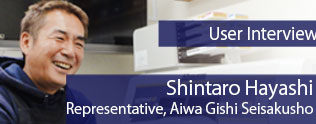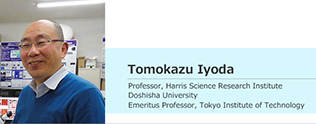Art students learn how to make raw materials in earnest?! – Report of visit to Joshibi University of Art and Design –

The Thinky Mixer is a device that is used by every industry, but it is sometimes used by a workplace that you would not dream of, making you wonder “why here?”
We paid a visit to an art university for the first time where we discovered a hitherto unknown relationship between the world of art and the Thinky Mixer. We held an interview with Professor Hiromichi Miyajima, Concentration in Japanese Painting, Department of Fine Arts, College of Art and Design, Joshibi University of Art and Design, which boasts a history of more than 100 years. We also observed a class by Specially Appointed Guest Professor Hideki Bitoh.
The fact that an art university is using the Thinky Mixer is very interesting and unexpected. What do you use it for?
(Miyajima) There are two planetary centrifugal mixers at Joshibi University. One is used for research and the other is used by students at the Pigment Creation Factory to make paint.

These were deployed at our school around 17 to 18 years ago. Four or five years after that, Professor Koan Hashimoto and Professor Bitoh took the lead and began using the mixers frequently in the research and development of artificial mineral pigments. Professor Hashimoto is a Japanese-style painter and a leading authority on mineral or natural pigments as well. He is also a member of The Society of Powder Technology, Japan (SPTJ) and is known for his uniqueness in the field of powder technology.
In Japanese-style painting, mineral pigments have been used from ancient times. The pigments are used after grinding natural colored minerals and mixing them with glue. Professor Hashimoto conducted classes from both physical and scientific perspectives, thereby communicating the message that students should understand materials for formative arts per se as the root of artistic expression.

*Left: Mineral pigments are used as paint after grinding natural colored minerals, such as azurite (ultramarine) and malachite (verdigris), and mixing them with glue.
*Right (classification of azurite and malachite): In the case of ultramarine, its hue varies with particle size. The finer the particles, the paler and the coarser, the darker the hue becomes. About 10 hues can be created gradationally out of a single stone. (Fine-particle paints look whitish due to diffuse reflection from the particle surface. In contrast, the coarser the paint particles, the darker the color becomes.)
In addition, it is said that the appeal of mineral pigments, which have evolved in a unique way, lies in the fact that their features vary according to the reflection of light, the amount used, or hues of the stone in itself after mixing ground powder with glue and daubing on Japanese traditional paper or silk.
When it comes to painting, you may tend to become preoccupied with what you wish to express. Painting itself is likely personal, or similar types of painting are repeated although they change with the times. However, there is another way to look at art from a somewhat different perspective…. In this sense, we believe that what Professor Hashimoto has been working on is extremely interesting.
What do you do at the Pigment Creation Factory specifically?
(Miyajima) This factory was built about two years ago for students who major in Japanese- and Western-style painting to make paint by themselves. Besides the Thinky Mixer, a wide array of instruments, such as a grinding mill or a roll mill, are also available.

*Left: The original machine has been dispatched for repair and a loaned machine is in place.
*Right: Color samples for paints. Nice and colorful!
Students enter our university taking for granted that “paints are sold” or “paints are in tubes.” But as they learn while using cutting-edge apparatus and technology in addition to classic techniques in the classroom, they gradually come to understand that paint is an industrial product. This way of conducting classes by combining classic techniques and modern technology is unique to Joshibi.
Today, students who major in Western-style painting learn how to make “My Own Paint” in class. We will use the Thinky Mixer so please watch how the mixer is used in a real-life situation later on.
Here is another unique professor….
Professor Bitoh, who conducts the class today, possesses a unique background as a professor at an art university. He used to draw oil paintings after graduating from Tokyo University of Science first and then Musashino Art University (Musabi). After graduating from Musabi, he worked for a variety of companies, including an oil paint manufacturer. He is an invaluable mentor who is knowledgeable in painting materials in addition to chemistry.

*Photo: Professor Bitoh, who is giving instructions to students at the Pigment Creation Factory.
Professor Bitoh, who is engaged in research on Western techniques, such as tempera, will deal with the techniques also in today’s class. According to him, the history of oil paints and pigments is related to how fine the oil paints and pigments have been ground.
Although I am not very familiar with oil painting, it seems that oil paints were needed to achieve some pictorial representation techniques and that oil paints have changed with the times. Take Van Gogh for example. Matiere (the effect of material on a painting) is fabulous, isn’t it? In the 20th century, an expression like his had gained added force. Oil paints up until then had been more transparent and oil painting involved a technique of layering oil paints and building layers of colors. What Leonardo da Vinci drew is called glazing, a technique of layering skin color on a gray background to bring out color. Because Professor Bitoh is very particular about classic oil painting, classic oil painting is also an important element in his class. “Classic oil paintings are different from current ones, so you can’t draw a painting like that using current paint,” he explains. Students understand this well if they attend his class.
For your information, the Pigment Creation Factory is used by students who major in Japanese-style painting as well, and in Japanese-style painting, people enjoy “particles of ground stones” in a sense. About 20 years ago, Professor Bitoh, who was working at a paint manufacturer, gave a lesson on paints. There he met Professor Hashimoto and the two of them have carried out a wide array of efforts since then. At that time, I heard that both found differences but were interested in each other’s way of viewing paint in western-style painting and its Japanese-style counterpart. In other words, one needed the other’s field of specialty mutually. They have jointly produced exciting results in their research since then.
By the way, Joshibi University developed artificial mineral paint and you were involved, weren’t you?
(Miyajima) Yes. It was developed by Professors Hashimoto and Bitoh and I became involved in coming up with the product named Eco Mineral Paint 21 and in wholesaling it as merchandise. I have expanded this initiative by taking over what has been developed carefully.

*Photo: Eco Mineral Paint 21 on sale
At Kiya, a Japanese-style painting material shop in Bunkyo-ku, Tokyo. There are a wide variety of colors!
I have been with Joshibi for the past eight years, including a part-time stint. Before that, research on techniques and materials was not the main focus of my activities. My focus was on painting and my expressions inevitably leaned toward something from time to time. Under such circumstances, however, I ended up working here and found myself involved in a wide variety of projects under the guidance of Professor Hashimoto. Eco Mineral Paint 21 was one of the major results.
There were so many things that I couldn’t figure out in the beginning, including how to use apparatuses. I tried my best to avoid anything and everything that dealt with chemistry, but found myself surrounded by it when I arrived at my destination. Although I was trying to run away from it, I was actually getting closer (laugh). Having said that, however, I feel that I’m absorbing so many fresh ideas. It’s as if I’m learning with students together while making discoveries.
I never dreamt of looking into a microscope as a professor at an art university …..
I had never dreamed of looking into a microscope, but now I am a member of The Society of Powder Technology, Japan (SPTJ) and have more opportunities to talk with people in the powder technology field than with those in the art field. Although it is something that I should be grateful for, it is scary that I have begun figuring out what they are saying little by little…. (laugh).
But I believe that you can’t draw a painting without things like these. I know this from experience. For example, there is an issue of paint chipping or cracking, but what is the cause of it? Clearly how powder grains are lined is important.
There have been a number of interesting activities at SPTJ. Last year, more than 200 SPTJ members gathered here at Joshibi to attend a symposium, and this year, a powder technology workshop was held here. These activities provided opportunities to promote communication, where you not only listen to talks but also expose yourself to artificial mineral paint to experience the fruit of our research firsthand. Art and powder technology are moving in completely different directions, but I assume that the two would make unexpected discoveries of each other once they meet. We held the workshop in pursuit of something like that.

*Left: Front cover of pamphlet containing many photos. The world that you see when looking into a microscope is condensed here.
*Right: On the back cover of the pamphlet is Eco Mineral Paint. The kit by which you can make natural mineral paint from pebbles is also available. You can learn about “real color” and the “color of the earth” easily.
What is the role of artificial mineral paint?
(Miyajima) As mineral paint is originally made by grinding rocks, it used to be mostly inorganic pigment. Thus, it is true that there is a problem with regard to its effect on the human body. For instance, natural vermilion is a mercury compound. It has been pointed out that it must have had quite significant effects on the health of painters in old times.
Currently, the number of paints using toxic cadmium has significantly decreased and that of organic pigments has increased instead. In the Japanese-style painting community, because you cannot express fully what you want to draw using natural colors alone, research has been consistently conducted over the years. Thanks in part to that, the number of artificial mineral paint colors has increased noticeably. I believe that this is linked to scientific advancement to a great degree.
Artificial mineral pigment is more of a modern concept. This is what I have said time and time again, and students start with this as the “gateway.” To students who are admitted to an art college around the age of 18 to 20, I assume that the world of Japanese-style painting may come across as unspectacular compared to that of Western-style paintings where reality or reproducibility is pursued. Against this background, if students understand the overall scheme of things using diverse artificial mineral paints at any rate, they may become increasingly attracted to the world of traditional Japanese-style painting, I think.

*Photo: Joshibi offers substantial educational programs for reproduction, which is one of its features. This is the national treasure Fan-paper album of Hokekyo Sutra (Heian Period) that junior students worked on in a reproduction project. Not only reproduction per se but framing was perfected as well. It is a real work of art.
The Eco Mineral Paint is used by many people including teachers of drawing classes and at school or a workshop of high school art teachers in Fukui Prefecture. In addition, we offer not only English but also German and Korean language support, so I expect its use abroad to expand down the road. This seems to have helped spread both Japanese-style painting and mineral paint, and I feel that it is gaining acceptance gradually.
In the United States, in particular, it is difficult to export normal mineral paint due in part to its toxicity, but because the Eco Mineral Paint is harmless, it was used at a workshop that Professor Hashimoto held recently in New York.
I believe that the fun of Japanese-style painting lies in the fact that there are a number of works in which much room is left for those who view them to complement colors because the number of colors of paints created from nature is limited. Moreover, I personally think that those who draw them find it fun, which is a theme, or one of the appeals, of Japanese-style painting.
The Eco Mineral Paint is mineral paint that is easy to use as the initial step. As its use expands gradually in that fashion, I would like to communicate the charm of Japanese-style painting widely.
Finally, what do you think of teaching at an art college from the perspective of the chemical field as well?
(Miyajima) Students work really hard on drawing. They create something unexpected from time to time. There are good and bad times, but because this is a place where people express themselves, there is no predicting how things will turn out if someone does something. Moreover, their effort won’t necessarily lead to making money, but I believe that young people’s attitude of devoting themselves to their expressions with passion is truly valuable. It is tough because it’s like going down a long path with no answer, but there is meaning or value in doing so.
We teach techniques rather than expression. This certainly gives them practical tips in some cases. Professor Hashimoto keeps suggesting scientific technology to students in a matter-of-fact fashion and I think that is what this is all about. The rest should be the student’s choice. It makes no sense if a student copies his/her teacher, because the student’s work will end up as not being his/her original. At a time like this, if you show something from a totally different field and have students take an interest in it, a whole new world would open up before them.
When it comes to something chemical, it may come across as leading edge, but if you expand this into the world of art and take advantage of an apparatus like the Thinky Mixer, it may come across as something extraordinary from the perspective of the general public.
In order to create things, I really feel that one must see good things. One’s values change with age, I think. I believe that art colleges should emphasize the fact that beauty lies in a wide variety of changes and things under such circumstances.
Report on our tour to the Pigment Creation Factory – Simplified paint manufacturing method –
In this class, students majoring in Western-style painting were learning how to make their own oil paint in a workshop. Watch how they did it.

* Left: Professor Bitoh’s secret recipe for “My Oil Paint” is distributed.
* Right: Professor Bitoh places a container with ingredients on a digital scale. “Here is the point!”

* Left: Professor Bitoh sets the balance dial. He explains how important it is.
*Right: Professor: “Will it go well?” Student: “I’m scared!” Professor: “Don’t be (laugh).”

*Left: “Here! We’ve come up with one!” Pigments, an oil medium, and an extender were beautifully mixed.
*Right: Students roared with pleasure, exclaiming, “Wow!” and “Amazing!” Some were clapping their hands!
We’d like to thank Professor Bitoh and all the students for allowing us to observe the class. Professor Bitoh said, “You are lucky enough to be able to use this device while you are still students.” We also heard him say that he had encountered an experience where he was not able to introduce the Thinky Mixer at his workplaces in the past.
Upon hearing the students say, “Wow!” we were pleased as well. We’d like to encourage you to make full use of the Thinky Mixer and come up with one fine piece of art after another down the road!
After the Interview
This time around, we visited Joshibi’s vast Sagamihara Campus, which is surrounded by a park. On the campus grounds, we found the following plants: Broussonetia kazinoki, Edgeworthia chrysantha, and Abelmoschus manihot, which are used in making Japanese traditional paper at Joshibi’s papermaking workshop. Besides the Joshibi Art Museum, several equipment and environments are available for students to devote themselves to creating works of art. Workshops are regularly organized and we would like to encourage those who are interested to join.
Joshibi University of Art and Design
Joshibi University of Art and Design was established in 1900 with a view to “helping female independence through art,” “improving women’s social status” and “fostering art experts and teachers” as a scholastic institution for conducting art education.
●Suginami Campus: 49-8 Wada 1-chome, Suginami-ku, Tokyo
Junior College of Art and Design, Department of Cross-Disciplinary Art and Design, Graduate School of Art and Design, Joshibi Junior High and High School of Art and Design, Corporate Headquarters, Alumni Headquarters, and Joshibi Galleria Nike
●Sagamihara Campus: 1900 Asamizodai, Minami-ku, Sagamihara City, Kanagawa Prefecture
Department of Fine Arts, Department of Design and Crafts, Graduate School of Art and Design, and Joshibi Art Museum
●website:https://www.joshibi.ac.jp/
Japanese painting material shop Kiya (distributor of artificial Eco Mineral Paint)
●Address: 44-8 Yushima 3-chome, Bunkyo-ku, Tokyo
●website:http://kiya.ehoh.net/


